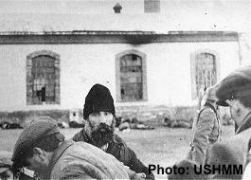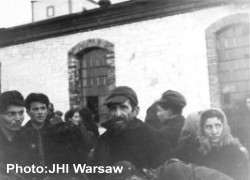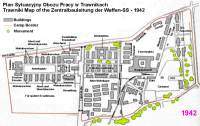 |
| Camp Map |
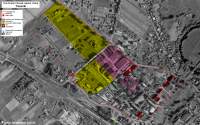 |
| Aerial Photo (1 MB) |
Trawniki village is located approximately 40 km east of
Lublin. In
autumn 1941, the Nazis established a labour camp at an old sugar factory, and an
SS training camp for SS recruits from Russia and the Baltic States.
Jewish Labour Camp
The camp housed Soviet POWs and Polish Jews, and belonged to the network of
camps under the control of
SS-Brigadeführer
Odilo Globocnik,
the
SSPF (SS- and Police Leader) in the
Lublin district.
In
spring 1942, Jews from Germany, Austria and Czechoslovakia were deported to
Trawniki. Many of these Jews died of starvation and disease, those who lived through this were resettled to
Belzec or were shot in the nearby forest.
In
winter 1942, a brush factory, located in the
Miedzyrzec Podlaski Ghetto, was transferred along with its
workforce to Trawniki. In
February 1943, the
Fritz Schultz factory in
Warsaw was transferred too, with 10,000 workers. The transferred factory
consisted of workshops for tailors, furriers and broom makers.
In
May 1943, Jews from the Netherlands,
Bialystok,
Minsk and
Smolensk were brought to Trawniki.
In
July 1943,
Osti (
Ostindustrie GmbH), which belonged to the SS,
requested that the Trawniki camp should be enlarged due to its importance to the German war effort,
producing uniforms etc.
In
August 1943, the training camp was overtaken by the
WVHA, and came under
supervision of the commander of the
KZ Lublin
(
Majdanek).
SS-Sturmbannführer
Georg Wippern became its
economic and administrative chief.
The Jewish prisoners were also employed in earth-moving and peat mining outside of the camp.
Following the uprising at
Sobibor on
14 October 1943,
the Nazis concerned over the possibility of further Jewish rebellions.
Heinrich Himmler
decided to liquidate all Jewish camps within the
Lublin district.
This extermination was called
Aktion Erntefest
("Action Harvest Festival"). On
3 November it was Trawniki’s turn to be eliminated:
10,000 Jews were taken out of the camp, brought to pits that had been prepared in advance, and shot.
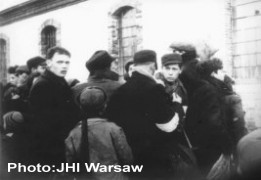 |
| Jews in front of the sugar factory* |
* These photos show Jews from the Trawniki camp on the first transport
to Belzec. They were deported together with Jews from
Piaski and Biscupice. In the course
of this transport several hundred Jews were locked up in a shed near the factory. Some
witnesses from Trawniki are convinced that a gassing experiment took place in the shed;
they got this information by Ukrainians from Trawniki. Others had the opinion that the Jews
in the shed died by lack of air. In any case the corpses were put into the cattle wagons
next morning, together with alive people.
In
spring 1944, the remaining prisoners in the camp were transferred to the
Starachowice labour camp in the
Radom
district.
Some 20,000 Jewish prisoners passed through Trawniki during its period of existence.
SS Training Camp
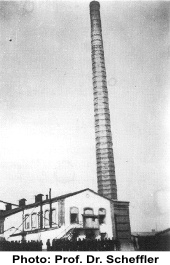 |
| The Sugar Factory |
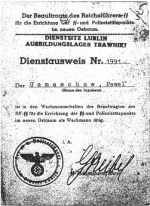 |
| Identity Card |
Following the Nazi invasion of the Soviet Union in
June 1941, the Nazis encouraged
Ukrainians, who were former soldiers of the Red Army and who had been captured, to join their cause.
Tens of thousands of Ukrainians volunteered for service in the German security services,
as well as Lithuanians, Latvians, Estonians and others.
Those former Ukrainian Soviet Army prisoners and local Ukrainians from West Ukraine (who volunteered for service
in
Aktion Reinhard) were sent to the SS training camp at Trawniki. In
October 1941,
SS-Sturmbannführer
Karl Streibel became appointed commander of the camp.
On
19 July 1942,
Himmler visited Trawniki. See our photo page!
The volunteer units were called "Trawnikis" or "Askaris" by the local population.
The Germans called them
Hilfswillige or
Hiwis for short, and the volunteers themselves
Wachmänner. In Trawniki the
Wachmänner received abbreviated military training and exercises,
including training for the deportation of Jews.
Approximately 2,000 - 3,000 guardsmen passed through the training camp during the two and a half years
of its activity. Some of them were organised into two battalions with four companies each, about 1,000 men
altogether. The size of a company was 100 - 200 men. One was a training company for squad commanders
(
Zugführer).
One or two companies were stationed permanently in
Lublin for security duties.
Other Trawniki units carried out guard duties in various institutions and labour camps in the
Lublin district.
To each
Aktion Reinhard death camp a unit with 90 - 130 men was allotted. Most of the squad commanders
were
Volksdeutsche, speaking German and Ukrainian.
See:
Late Trawniki Trials.
Sources:
Gutman, Israel.
Encyclopedia of the Holocaust
Arad, Yitzhak.
Belzec, Sobibor, Treblinka
Dr. Robert Kuwalek, Majdanek Memorial
Jewish Historical Institute, Warsaw
 |
 |
 |
 |
| Kommandantur 2002 |
Monument 2002 |
Camp Wall 2002 |
Factory 2002 |
© ARC 2005













